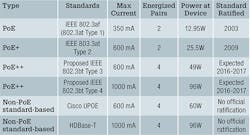From the June 2015 Issue of Cabling Installation & Maintenance Magazine
Two new flavors of IEEE-specified Power over Ethernet are in the works, and non-IEEE technologies are already common. What does it mean for cabling?
It has been said many times, in live and online seminars, that typically industry standards are at least a step or two behind the latest technological developments-catching up the best they can but almost always trailing, not leading, the capabilities being made available to a market. That refrain holds true today for the technologies that enable the powering of network devices using twisted-pair copper cabling as the medium that carries appropriate wattage to those powered devices. Collectively, the technologies that enable this type of device powering commonly are referred to as Power over Ethernet (PoE). As we published in an article last year, the use of that term has drawbacks as well as benefits ("Why the industry needs a PoE Logo Program," October 2014). Nonetheless, the term PoE is widely used as an inclusive term, and we will use it in this article as well.
To date, the Institute of Electrical and Electronics Engineers (IEEE; www.ieee.org) has published two sets of specifications defining these capabilities. IEEE 802.3af (commonly called simply "PoE") specifies the generation of up to 15.4 watts of power, with 12.9 watts delivered to the powered device (PD). And IEEE 802.3at (commonly called "PoE Plus,") specifies the generation of up to 34.2 watts of power, with 25.5 watts delivered to the PD.
Ty Estes, director of marketing at Omnitron Systems Technology Inc. (www.omnitron-systems.com), explained, "The IEEE standard for 60W, also known as PoE++, is currently in development with the IEEE 802.3bt Type 3 Work Group, and is projected to be ratified in early 2017. In lieu of a 60W PoE standard, equipment manufacturers have doubled the 802.3at PoE+ capability on four pairs, and powered all eight pairs to achieve 60 watts."
Going beyond IEEE
To Estes's point, in 2010-the year after IEEE 802.3at was published-Microsemi's (www.microsemi.com) director of product management and product marketing, Sani Ronen, explained, "Four-pair powering is supported in the latest PoE standard, and uses all four pairs of Ethernet cable to enable up to 60 W of DC [direct current] power to be delivered over a single cable using current levels of 600 mA … To enable these powering levels, the IEEE specifications changed the definition of a PD so that it considers the PD the power interface, as opposed to the whole device being powered. This means that there can now be two power interfaces, each taking 25.5W, in the same box. Nothing precludes these from being connected, one over two pairs using lines 1, 2, 3, and 6 and the other two over the two pairs using lines 4, 5, 7, and 8. This is what makes it possible to double the standard 802.3at-2009 maximum of 25 W and go up to 51 W while fully complying with the standard."
In 2011, Cisco (www.cisco.com) debuted its Universal Power over Ethernet (UPOE) system, which delivers 60 W to PDs. At the time of that announcement, Cisco's Catalyst 4500E switch was the infrastructure that housed the 60-watt UPOE capability. The company said target applications for UPOE included IP phones, personal telepresence systems, compact switches and wireless access points. Others also have pointed out that some IP cameras can benefit from more power than that afforded by IEEE 802.3at. Specifically, cameras that reside outside and require temperature-control in the form of blowers and heaters are power-hungry, and are often referenced as the types of network devices pushing the need for higher power delivered via cabling.
Omnitron provides an array of media converters, including models that provide PoE. In that vein, Estes noted, "In addition to the increasing power required by PoE devices, the 100-meter distance limitation of UTP cabling is a challenge in large facilities like airports, arenas, building complexes, and government facilities. High-power media converters can power the latest generation of 60-watt devices that have emerged onto the market, and extend distances with fiber cabling."
In 2011, the same year Cisco introduced UPOE, the HDBase-T Alliance (www.hdbaset.org) released the Power over HDBase-T (PoH) specification, which defines the delivery of up to 100 watts of power over a single cable, up to 100 meters. At that time Daniel Feldman, vice president with Microsemi, explained, "Core PoE technology has been enhanced for the PoH specification to include a higher current of almost 1 Amp for every two pairs, with an appropriate three-event classification that identifies PoH power sourcing equipment [PSEs]. This enables PoH technology to transfer up to 100 w of continuous DC power, per port, from one side of the HDBase-T link to the other. Unlike in PoE, where the PD must assume a worst-case cabling infrastructure at all times, PoH enables the PD to identify the cable length/resistance and draw more power, as long as the overall power consumption does not exceed 100 W."
Feldman's comment broaches the topic of cabling performance level and support of PoE/PoH. That topic has been, and remains, the subject of significant study as the IEEE moves forward with its latest PoE specifications. As Estes mentioned, IEEE 802.3bt is under development. Within IEEE nomenclature, the 802.3af specification is known at "Type 1" PoE, and 802.3at is known as "Type 2." The current effort, 802.3bt, is likely to include a "Type 3" and "Type 4" PoE. Type 3 will specify a current level up to 600 milliAmps (mA) and 49 watts at the powered device, while Type 4 will specify a 1,000-milliAmp (1 Amp) current level and 96 watts at the powered device.
Cabling implications
In April at the Ethernet Technology Summit (www.ethernetsummit.com), Frank Straka, product development manager with Panduit (www.panduit.com), addressed the issue in a presentation titled "100W PoE++'s Impact on Infrastructure." Just as 802.3af has become known as "PoE" and 802.3at as "PoE Plus," 802.3bt is being dubbed "PoE Plus Plus" in some circles. (Note: This author did not attend the Ethernet Technology Summit, but did obtain the visuals of the presentation that Straka delivered. The summary that follows is derived from those visuals. The table within this article also is reproduced from Straka's presentation.)
Among other topics, Straka addressed the extent to which heat rise within cable bundles could have deleterious effects on cabling system performance when those cables are carrying 100-watt PoE. Straka's presentation noted, "Cable temperature matters because some temperature rise will increase cable insertion loss and may create bit errors; extreme temperature increase above the cable operating range can damage the cable." Cable manufacturers, he noted, will provide users with information about the maximum bundle size that can meet the 15-degree temperature rise limit recommended in the TIA TSB-184 document, "Guidelines for Supporting Power Delivery Over Balanced Twisted-Pair Cabling." Straka stated that the equation that should be used when planning for higher-power PoE is: cable temperature rating is less than or equal to the ambient temperature plus 15.
He pointed out that of PoE and PoE Plus, Category 5e, 6, and 6A cables all complied with TSB-184's 15-degree maximum temperature rise when tested in bundles of 100 cables. However, during testing of 802.3bt pre-standard technology, only Category 6A cables stayed within the 15-degree recommendation. A couple recommendations to take away from these test findings are that Category 5e and 6 runs should be assembled in bundles of fewer than 100 cables. And, as one line in Straka's presentation stated, "If thinking of running PoE++, Category 6A cabling is recommended."
Much remains to be determined concerning the type of cabling that will adequately support IEEE 802.3bt, and the physical placement and layout of that cabling. The TIA also is in the process of revising TSB-184 to address 802.3bt support.
Examining options
In a recently published technical paper titled "Power Over Ethernet: A Consumer-centric Development Perspective," General Cable (www.generalcable.com) communications-products engineer Roy Kusuma also addressed temperature-rise considerations in cable bundles. In the paper Kusuma points out, "In many cases a large cable bundle may be present under the floors, behind walls or enclosed in an insulated space. In the last circumstance, the heat rise figures are significantly worse, with numbers as high as 50 degrees Celsius above ambient temperatures for the typical worst-case Category 5e construction.
"Currently, in applications where higher power usage is expected in excess of 50 watts, yet higher data transmission rates are not required, there are few, if any, options," he continues. "To appropriately address the increased temperature rise, one could be confined to using Category 6A [UTP] or Category 6A F/UTP. The limiting factor of many devices, especially IP cameras, nurse call systems, building management controls and point-of-sale is power consumption, not data. This places a difficulty on premises designers to justify the use of higher category cabling or the need to pull a power source onto a location."
Portions of the technical paper discuss and support the use of Category 6 cable designed specifically for supporting higher-power PoE applications. "There are real benefits to using specially designed PoE cabling with properties such as larger, lower-gauge conductors and higher temperature cable ratings for the majority of PoE applications," Kusuma says. "Aside from having the confidence that the cable will withstand higher temperature operations and generate lower temperatures, energy savings and efficiency are also considerations when deploying a large-scale PoE infrastructure."
Straka's presentation at the Ethernet Technology Summit also addressed the phenomenon of arcing, or sparking, that can occur on twisted-pair cabling contacts when a plug is removed from a jack. "Arcing damage may prevent data transmission through the plug and jack," the presentation stated plainly. Additionally, it said, "Connectors should meet IEC 60512-9-3 and IEC 60512-99-001 to ensure that when (not if) arcing occurs, it will not damage the critical plug-and-jack mating point where the plug is fully engaged."
In a post to Leviton's blog (blog.leviton.com) in January 2015, the company's senior product manager for copper systems, Grayling Love, discussed several of the cabling issues addressed in this article. Concerning connection reliability, Love noted, "When a patch cord is unplugged while the connection is charged, an electrical arc will occur between the connector and the plug. While there is no immediate damage (and the arc is not dangerous to users), the integrity of the connection can become weakened over numerous disconnections. To add extra protection and longevity to the life of the connection, Leviton recommends using connectors with 50-μm gold-plated tines (as specified by TIA standards), as well as designs that distance the connection point between the connector tines and plug from the arcing damage." Love also referenced the IEC 60512-99-001 standard covering connectors for electronic equipment. "High-quality connectivity is essential for attaining the performance, reliability, and flexibility needed in today's network operations," he added.
In the case of powering network devices with upwards of 100 watts of DC, industry standards may indeed be a step or even two steps behind the technologies being brought to market. But the testing and investigation going into the standardization process-within the IEEE as well as the TIA-are for the purpose of ensuring, to the extent possible, that an installed standard-compliant system can be relied upon as an enabling infrastructure for data and power delivery. The standards currently under development are no exception. When ultimately published, these standards will guide the installation of powered devices, power sourcing equipment, and cabling systems around the world.
Patrick McLaughlin is our chief editor.

